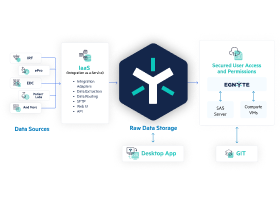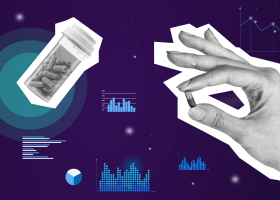What Is a Statistical Computing Environment?
Let’s jump in and learn:
- What Is a Statistical Computing Environment?
- Key Features and Functions of a Statistical Computing Environment
- Benefits Realized with a Statistical Computing Environment
- Uses for Statistical Computing Environment
- How Can a Modern Statistical Computing Environment Promote Innovation and Accelerate Clinical Trials?
- The Future of Statistical Computing Environment Platforms
- A Statistical Computing Environment Streamlines and Expedites Clinical Trials
What Is a Statistical Computing Environment?
A statistical computing environment is a system that provides a set of tools for the computational processing, analysis, documentation, and reporting of clinical data. Life sciences organizations use a statistical computing environment to manage the versioning, security, and integrity of data, programs, and outputs used in clinical data analysis. A statistical computing environment helps improve the transparency, efficiency, traceability, reproducibility, and visibility of clinical data statistical analyses.

A statistical computing environment facilitates access to clinical trial data from different sources at different stages of drug development. It also supports the development of analysis datasets, tabulation datasets, table listings, and graphs, and submission components for all clinical trial-related deliverables to ensure compliance with regulations and GxP. A statistical computing environment provides programmers, statisticians, and data scientists with an agnostic workspace for modeling and simulations using multiple programming languages, such as Julia, MATLAB, Perl, Python, R, S+, shell scripts, and statistical analysis system (SAS).
Several reasons why an organization would need a statistical computing environment are:
- Existing environment does not support large-scale predictive analytics
- Lack of a controlled environment to develop and execute programs
- Limited to no program re-use
- Need to maintain audit tracking
- Programming processes require excessive manual intervention
- Statistical programmers geographically distributed
Key Features and Functions of a Statistical Computing Environment
Among the many features and functions of a robust statistical computing environment are the following.
Dependency tracking visualizations
A statistical computing environment provides a view of the flow of data from to target, visualizing end-to-end workflows.
Flexible user interface and user experience (UX)
To optimize productivity, a statistical computing environment complements a user-centered design with options for users to customize as needed to support unique use cases.
Integrations
To enable a statistical computing environment to interact with other systems and import and export data seamlessly, a statistical computing environment provides APIs to support integration with other applications and outside users, such as contract research organizations (CROs).
Metrics
A statistical computing environment can present standard or customized reports or dashboards that display metrics collected that are collected. These metrics can be used to assess performance by comparing them to another organization’s metrics or an industry baseline.
Regulatory compliance
Among the features that a statistical computing environment includes to ensure regulatory compliance are:
- Audit trail
- Access controls
- Electronic signatures
- Traceability
- Version control
Scalability
A statistical computing environment must be scalable to meet the requirements of different data structures and fluctuating demand that comes with statistical models for clinical data.
Traceability
Traceability capabilities should be part of a statistical computing environment. It should provide the ability to trace final tables, listings, and graphs to raw data.
Version control
In addition to providing execution history, a statistical computing environment needs to include version control and tracking (i.e., of code, data, metadata, and execution environment) to enable the complete reproduction of results. Any changes should be tracked through version control and have audit trails that document who accessed the statistical computing environment, when, and what operations or changes were executed.
Workflow automation
By automating workflows, a statistical computing environment brings automation to statistical analysis. This includes automatically:
- Creating programs based on templates
- Scheduling programs to execute when data is updated
- Visualizing data flows from source to output
Benefits Realized with a Statistical Computing Environment
- Ability to automatically create programs using configurable templates
- Access to all data and metadata across the system
- Auditable, automated, reproducible, secure, and transparent submission or exploratory analysis outputs
- Automated, visualized workflows that support study processes
- Collaborative editing and review
- Complete software development lifecycle tracking
- Comprehensive version control of programs
- Increased development efficiency
- Support for programming languages such as SAS, R, and Python
- Regulatory compliance (e.g., 21CFR Part 11)
- Self-service access to data and analytics across studies and program
- Out-of-the-box capabilities
- Version tracking of code, data, metadata, and execution environment
Uses for Statistical Computing Environment
- Collect transactional and metadata to create reports based on performance metrics.
- Generate a complete study documentation package with information about programs used, reports created, and the relationships between raw and analysis datasets.
- Leverage notifications, version controls, and automated process management to increase collaboration between stakeholders.
- Manage active data and metadata to enhance quality and minimize errors in reports.
- Meet 21 CFR Part 11 and GxP requirements with full traceability, transparency, and audit capabilities.
- Perform analysis using Facilitates biostatisticians and statistical programmers work collaboratively to develop submission-ready statistical reports and exploratory analysis using a variety of programming languages, such as programming languages, such as Julia, MATLAB, Perl, Python, R, S+, shell scripts, and statistical analysis system (SAS).
- Provide CROs and other partners access and deposit into approved parts of the statistical computing environment.
- Use an integrated repository to enable efficient version control and change management.
How Can a Modern Statistical Computing Environment Promote Innovation and Accelerate Clinical Trials?
A statistical computing environment accelerates clinical trials, increases efficiency, and promotes innovation by providing a central workspace for managing, processing, and analyzing data while meeting regulatory compliance requirements. Foundational elements of a statistical computing environment that enables this are the following.
Analysis and reporting
- Transparency
- Reproducibility
- Documentation
Automation
- Data refresh triggers automatic program execution
- Notifications, with impact analysis, sent when structural changes are made to data
- Programs automatically created based on customizable templates
Democratized access to analytics and data science
- Reduce the barriers to entry for researchers with limited computational expertise
- Support the delivery of explainable insights
- Use cloud-based systems to provide powerful computational resources to resource-limited settings
Future-proofing
- Advanced analytics
- Artificial intelligence
- Machine learning
Development
- Version control
- Lifecycle workflows
- Reusable code snippets, functions, and macros
Security
- Access management
- Data protection systems and processes
- Validated environment
The Future of Statistical Computing Environment Platforms
Experts expect the future of statistical computing environments to reflect an increased and more sophisticated use of advanced analytics, artificial intelligence, and machine learning. Also expected is a significant increase in scalability to support the growth in data produced for and used in clinical trials. In addition, future statistical computing environments are expected to see expanded functionality to further facilitate the drug development process by enhancing data analysis, tabulation, validation, and submission of deliverables. The future statistical computing environments will expedite the research, development, and delivery of pharmaceuticals.
A Statistical Computing Environment Streamlines and Expedites Clinical Trials
As they are today, statistical computing environments consistently deliver value. When new research and development are integrated into these systems, and new versions are made available, statistical computing environment solutions are guaranteed to exceed current returns on investment. Organizations that work with a statistical computing environment sooner rather than later will gain a material, competitive edge.
Egnyte has experts ready to answer your questions. For more than a decade, Egnyte has helped more than 16,000 customers with millions of customers worldwide.
Last Updated: 14th November, 2023



